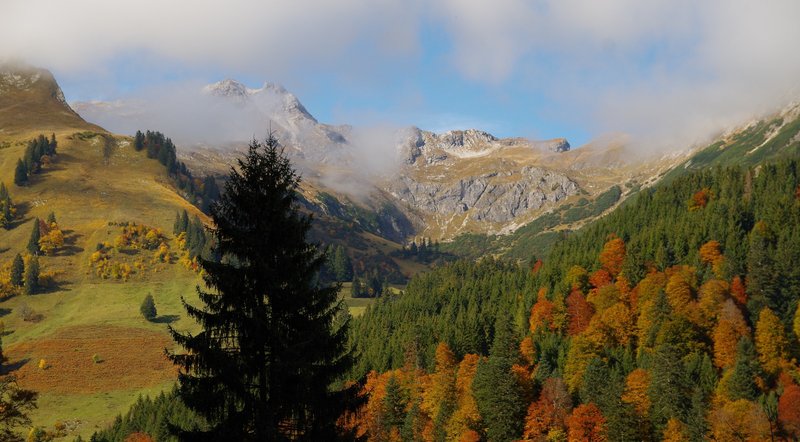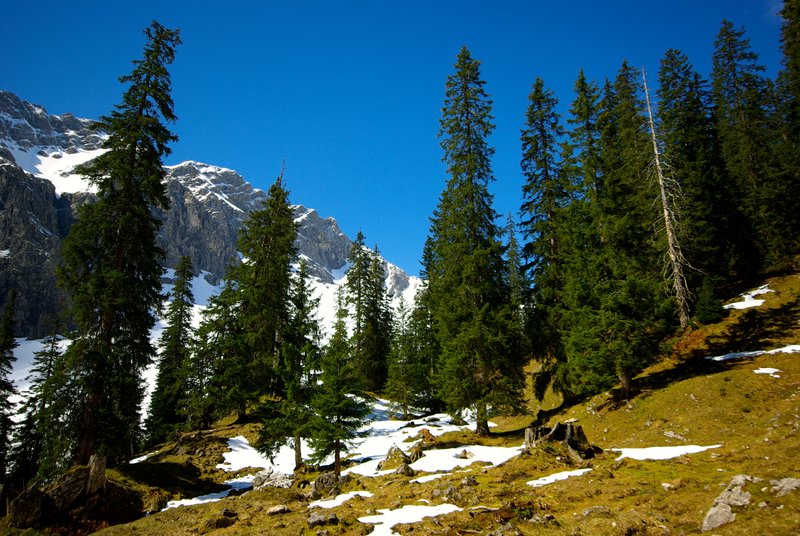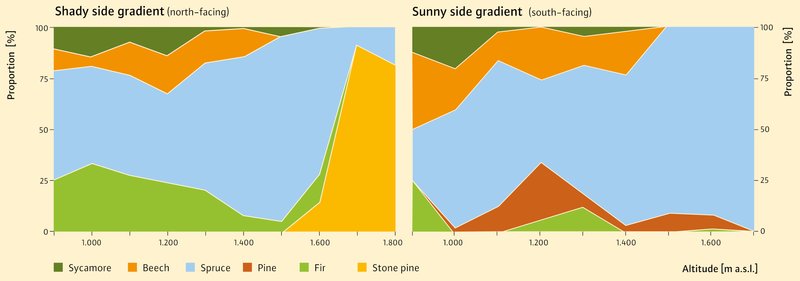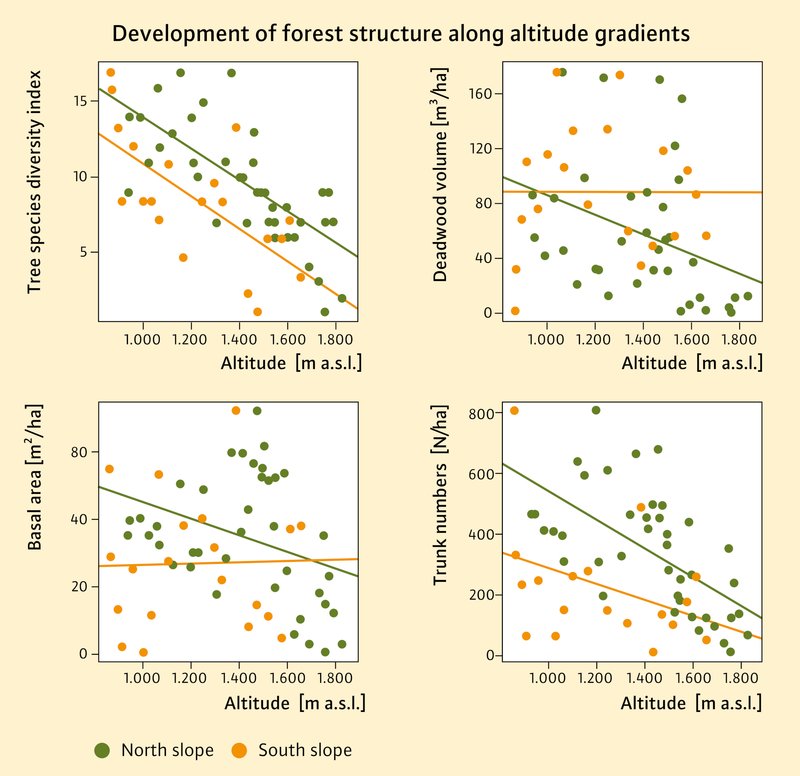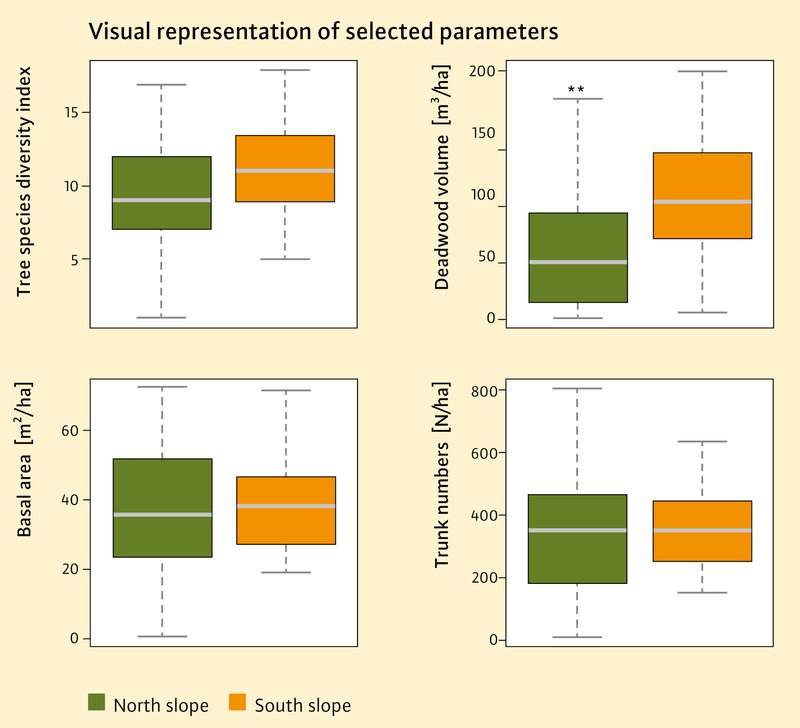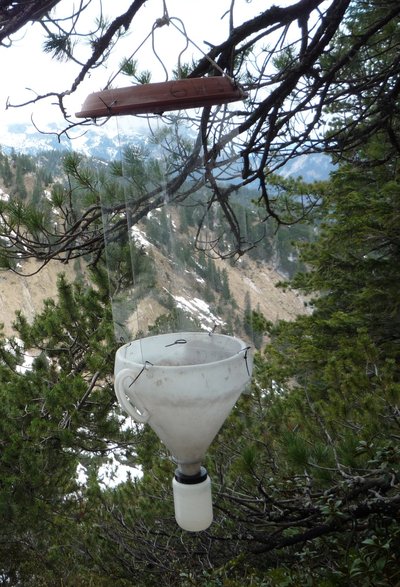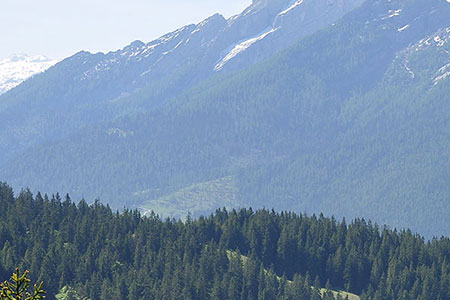Mountain forests are of great importance for diverse ecosystem services. These include the storage of CO2, the provision of water and wood, or protection against natural hazards such as rockfall and avalanches. In addition, the mountain forests of the Bavarian Alps provide a valuable habitat for numerous species of animals, plants and fungi. However, changing climatic conditions pose great challenges for the mountain forest ecosystem. The mountain forests in the Alpine region are particularly affected by the effects of climate change. In the Eastern Alps, the temperature has risen by just under 2 °C in the last 100 years. In comparison, the global increase in temperature was only about 0.8 °C.
The forecasts for the next 50 years also predict double the increase in temperature for the Alps in comparison with the adjacent lowlands. These changes are expected to have massive impacts on mountain forest ecosystems and ecological communities. Since different species do not react in the same way and speed to climatic changes, the species communities of our mountain forests will in all likelihood change and possibly be completely reorganised. Against this background, it is more necessary than ever to study the effects of a temperature increase on the species and species communities in order to be able to make predictions about the effects of climate warming on the species composition of mountain forests.
Project Altitude Gradient
In the project “Effects of Climate Change on Diversity and Structure of Mountain Forests in the Bavarian Alpine Region”, two altitudinal gradients were established in the Werdenfelser Land region, each reaching from the montane to the subalpine zones.
One of the altitudinal gradients is in the Jakelberg strict forest reserve [“Naturwaldreservat”] and the natural forest areas [“Naturwaldflächen”] above it; it represents the south-facing and thus warmer sites. The second gradient comprises the predominantly north-facing slopes of the Schrofen and Wettersteinwald strict forest reserves as well as set aside protection areas of forest [“Naturwaldflächen”] between them.
Along the sunny slopes gradient, between 850 and 1,640 m a.s.l., a total of 20 sample plots were established. On the shaded slopes there are 28 sample plots reaching in altitude from 900 to 1,800 m above sea level. On these 48 plots, the forest structure (living stand, deadwood, regeneration), ground vegetation, birds and arthropods are being mapped. In order to obtain information on the microclimate, two temperature logs have also been placed on each experimental plot. A camera trap at the sampling point records the occurrence of other animal species (e.g. grouse, mammals). The mapping along the altitudinal gradients is to be used in particular to predict the adaptation of different species and species groups or ecological communities to future climate conditions.
Structures change with altitude
The forest structures on the sample plots were recorded mainly in 2021. This was followed by the biodiversity survey in 2022. In this respect, initial statements are possible on how the forest structures change along the two altitudinal gradients. As expected, the tree species composition on the experimental plots varies across the altitudinal levels. On the steep south-facing slopes of the Jakelberg strict forest reserve, the lower altitudes (up to around 1,000 m a.s.l.) are characterised by spruce, beech, fir and sycamore. Between 1,000 and 1,500 m a.s.l., fir and sycamore recede as mixed tree species, often being replaced by pine on the comparatively shallow soils and dry and warm sites there. Finally, spruce dominates on the highest areas of the gradient (Figure 3). From a vegetation point of view, the sample plots can be classified as moderately fresh to moderately dry mixed carbonate mountain forest (Aposerido-Fagetum; low and medium altitudes) or as deep subalpine carbonate spruce forest (Adenostylo-Piceetum; high altitudes).
The tendentially north-facing, shaded slopes of the gradient (Schrofen and Wettersteinwald strict forest reserves) are characterised over long stretches by a moderately fresh mixed mountain forest of spruce, fir, beech and sycamore, with the proportion of spruce increasing with increasing altitude, especially at the expense of fir. From approx. 1,400 m a.s.l., lower subalpine carbonate spruce forests replace the mixed mountain forests. These transition from 1,600 m a.s.l. into a stone pine forest (Vaccinio-Pinetum cembrae), with stone pine as the main tree species, and spruce as a secondary tree species (Figure 3). The larch, which is actually typical for this type of forest, is largely absent in this area.
The tree species diversity in the strict forest reserves studied decreases with increasing altitude (Figure 4). This correlation applies equally to the sunny side gradient and the shady side gradient and reflects the transition from the mixed mountain forests, which are richer in tree species, to the subalpine coniferous forests, which have fewer tree species. For this, a diversity index was calculated that takes into account not only the tree species but also the breast height diameter (BHD) of the trees. It reflects the number of combinations of tree species and BHD and is thus a combined measure for the species and structural diversity of the living tree population.
Differences, however, were observed in the amount of deadwood and the basal area of the living stand. While neither parameter shows any change over altitude on the south-facing slopes, there was a decrease in both cases with increasing altitude on the shaded slopes. It should be noted that the values between 800 and 1,600 m above sea level are relatively evenly distributed, and only decrease significantly above 1,600 m above sea level. The decline in the amount of deadwood and stand basal area on the shaded slopes is mainly due to the occurrence of high subalpine larch and Swiss stone pine forests there, which, from 1,600 m above sea level, take over from the high altitude spruce forests that are richer in deadwood and have a higher basal area.
Differences between sunny and shady sides
The fact that there are differences in the forest structure between the north- and south-facing slopes can be seen in the tree species composition of the experimental plots (see above). The warmth-favoured sunny slopes are characterised by the occurrence of Scots pine, especially in the middle altitudes, while the occurrence of Swiss stone pine-dominated stands is characteristic of the high altitudes of the shady slopes. On the other hand, the supply of standing and lying deadwood differed significantly between the two gradients, with the drier and warmer southern slopes having considerably higher amounts of deadwood on average (Figure 5). One reason for this is assumed to be a higher rate of tree mortality (e.g. due to bark beetle infestation) on these sites, which are prone to phases of drought. On the other hand, there are hardly any differences in tree species diversity, the basal area of the living stand and the number of stems between the sunny and shady slopes.
So what is next?
The project year 2022 will be used especially to investigate the species composition and diversity on the sample plots. For recording the arthropods, crossed-window traps (for the trapping of flight-active species; Figure 6) and ground traps are being used, with the trapping period lasting from around the beginning of May to mid-August. The determination of the insects caught is predominantly carried out via automatic gene sequencing of the collected samples.
The bird species are recorded on grid squares of one hectare in area, using combined point-stop-territory mapping, with the 48 sample plot centres representing the centre of the respective grid square. All visual and acoustic evidence of species is documented as precisely as possible. This mapping took place in three rounds between the beginning of May and the end of June.
The mapping of plants in the forest ground vegetation was carried out once during the vegetation period, following the standard Braun-Blanquet procedure on sampling circles of 314 m² in area. All vascular plants and soil-dwelling mosses are recorded with their respective cover levels as well as the height and total cover of the different vegetation layers.
The recordings of species along the two altitudinal gradients form the basis for investigating the influence of the changes in temperature or forest structures occurring with changes in altitude on the occurrence of individual species. These correlations can be used to predict climate change-induced changes in species composition. Strict forest reserves offer optimum conditions for this, as forest operations can be excluded as a further influencing factor. In addition, the sample plots will in future serve as monitoring plots for long-term observation of changes in biodiversity in the mountain forest zone of the Bavarian Alps.
Summary
This project investigates the effects of climate change on the structure and species composition of the mountain forests in the Bavarian Alpine region. In order to do so, two altitudinal gradients (montane to [high] subalpine) were established in three strict forest reserves, along which the forest structure was initially recorded in 2021. The initial data evaluations show changes in tree species composition and diversity as well as in the horizontal stand structure. There were also differences between north- and south-facing slopes. In 2022, the species composition of selected indicator groups is being determined, in order to derive relationships between the occurrence of the species and selected environmental and structural parameters. The findings can be used to predict climate change-induced changes in species composition.
The project klifW007 on the “Effects of climate change on the diversity and structure of mountain forests in the Bavarian Alpine region” (running time: 01.04.2021 - 31.03.2024) is being funded by the Bavarian State Ministry of Food, Agriculture and Forestry.

